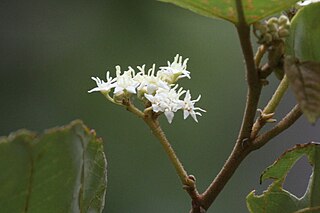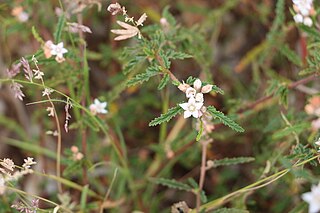
Notelaea is a genus of flowering plants in the family Oleaceae and is endemic to Australia. Plants in the genus Notelaea are shrubs or small trees with leaves arranged in opposite pairs, flowers arranged in racemes in leaf axils with small sepals and 2 pairs of petals joined in pairs, 2 stamens and an ovary with 2 ovules with a 2-lobed stigma.

Boronia forsteri is a plant in the citrus family Rutaceae and is endemic to mountain ranges in central Queensland, Australia. It is an erect shrub with many branches, simple leaves with a densely hairy, pale underside, and pink, four-petalled flowers.

Boronia squamipetala is a species of plant in the citrus family, Rutaceae, and is endemic to Queensland, Australia. It is an erect shrub with pinnate leaves with between five and thirteen elliptic leaflets, and green to white, four-petalled flowers with hairy backs.
Leptospermum pallidum is a species of spreading shrub that is endemic to Queensland. It has thin, firm, rough bark, narrow lance-shaped leaves, white flowers arranged in groups of two or three on side shoots and fruit that remains on the plant until it dies.
Acronychia eungellensis, commonly known as Eungella aspen, is a species of small rainforest tree that is endemic to a restricted area in east-central Queensland. It has simple, elliptic leaves on cylindrical stems, flowers in small groups in leaf axils, and fleshy fruit that is elliptic to egg-shaped in outline.
Eremophila woodiae is a flowering plant in the figwort family, Scrophulariaceae and is endemic to western central Queensland. It is a small shrub with linear to lance-shaped leaves crowded near the ends of the branches, hairy sepals and violet to light purple petals.

Elaeocarpus grahamii is a species of flowering plant in the family Elaeocarpaceae and is endemic to north-east Queensland. It is a small to medium-sized tree, sometimes coppicing, with elliptic to egg-shaped leaves, flowers with five petals that have a frilled tip, and oval blue fruit.
Triplarina calophylla is a species of flowering plant in the myrtle family, Myrtaceae and is endemic to a restricted area of north Queensland. It is a shrub with egg-shaped leaves with the narrower end towards the base, flowers with five sepals, five white petals and fourteen or fifteen stamens.
Triplarina nitchaga is a species of flowering plant in the myrtle family, Myrtaceae and is endemic to a restricted area of north Queensland. It is a shrub with lance-shaped leaves with the narrower end towards the base, flowers with five sepals, five white petals and seventeen or eighteen stamens.
Hibbertia hendersonii is a species of flowering plant in the family Dilleniaceae and is endemic to the Blackdown Tableland in Queensland. It is an erect shrub with densely hairy foliage, narrow elliptic leaves, and yellow flowers, each usually with twenty to thirty-one stamens arranged on one side of the two carpels.
Notelaea pungens is a species of flowering plant in the olive family that is endemic to south-eastern Queensland, Australia.

Daviesia discolor is a species of flowering plant in the family Fabaceae and is endemic to Queensland. It is a glabrous, multi-stemmed shrub with linear, more or less sickle-shaped phyllodes, and yellow and dark red flowers.

Styphelia blakei is a species of flowering plant in the heath family Ericaceae and is endemic to inland southern Queensland. It is a sometimes prostrate, twiggy shrub with hairy branches, egg-shaped leaves with the narrower end towards the base, and small white flowers.

Commersonia macrostipulata is a species of flowering plant in the family Malvaceae and is endemic to Queensland. It is a shrub or tree with egg-shaped leaves that are slightly serrated on the edges, flowers with five cream-coloured to white sepals and bristly fruit.
Androcalva inglewoodensis is a species of flowering plant in the family Malvaceae and is endemic to south-eastern Queensland. It is a spreading, prostrate shrub that has hairy young branchlets, egg-shaped to elliptic leaves with irregularly serrated edges, and small groups of white to cream-coloured flowers.

Androcalva johnsonii is a species of flowering plant in the family Malvaceae and is endemic to central Queensland. It is a low, spreading shrub that has hairy young branches, narrowly egg-shaped or oblong leaves with rounded teeth, and small groups of white to pale pink flowers.

Androcalva pedleyi is a species of flowering plant in the family Malvaceae and is endemic to south-eastern Queensland. It is low, spreading or prostrate shrub that forms suckers and has softly-hairy new growth, linear to lance-shaped leaves with lobes on the edges, and groups of 7 to 10 white, later pink flowers.
Micromyrtus gracilis is a species of flowering plant in the myrtle family, Myrtaceae and is endemic to central Queensland. It is a slender shrub with overlapping, egg-shaped leaves and white flowers arranged singly in leaf axils with 5 stamens in each flower.
Styphelia lucens is a species of flowering plant in the heath family Ericaceae and is endemic to coastal areas of north Queensland. It is a shrub with densely hairy branches, erect, lance-shaped leaves with the narrower end towards the base, and white, tube-shaped flowers.

Palmeria foremanii, commonly known as anchor vine, is a species of flowering plant in the family Monimiaceae and is endemic to an area near the New South Wales - Queensland border. It is a tall, woody climber or scrambling shrub with usually elliptic leaves, male and female flowers on separate plants with 5 tepals, male flowers with 40 to 43 stamens, female flowers with 7 to 12 carpels, and spherical, shiny black drupes.












